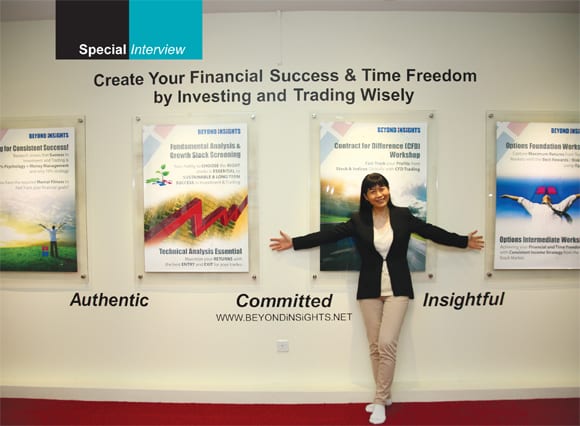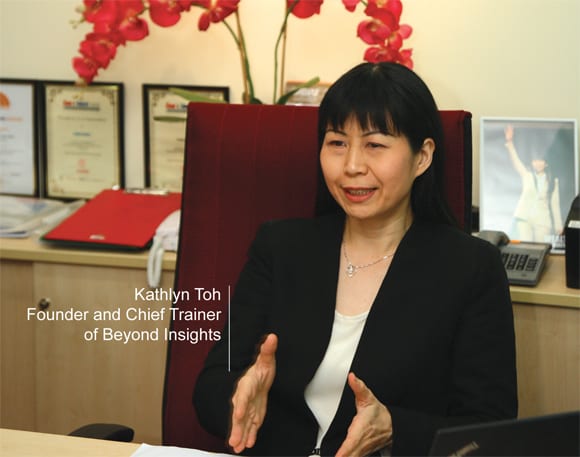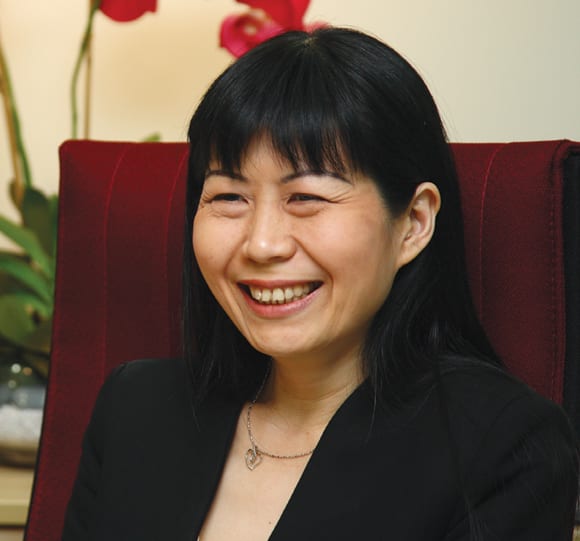Published in Money Compass Magazine 2014 January issue. Original article here.

{“I realised that it has much to do with psychology and money management which was not really emphasised and had not much to do with learning more strategies.”}
Most of the financial training courses in the market typically tell you how easy it is to make money, but what they are hiding from you is that more than 90% of people are actually losing money.
The key problem here is not about the trading strategies applied. It is the trading psychology and money management that make the difference.
Top investors and traders like Kathlyn Toh believe that 90% of consistent success in trading lies in psychology and money management and only 10% in strategy. Unfortunately most people still focus too much on strategy.
Kathlyn Toh, who is also the founder and chief trainer of Beyond Insights said in an exclusive interview with Money Compass that, in the early days when she was assistant to her “guru” and coach to more than 1000 students, she found many students were actually losing their money especially in Forex trading.
The fact is a lot of the financial training courses typically over promise on how easy it is to make money, but these courses omit the truth that more than 90 % of people are actually losing their money.
However, she said, people were reluctant to pay for something unless it is linked to earning more money. Thus, when there is talk about psychology, people were unwilling to pay for it although it is one of the key components to ensuring consistent success in trading.
Nevertheless, Toh who was inspired by Tony Robbins on people transformation is committed to helping people make the change and get their personal insights on trading. She has conducted and facilitated many successful leadership, management and employee development training courses while working at Intel Corporation.
Beginning as a voluntary coach who turned into the professional trainer, Toh started a trading psychology course as she felt it is a missing gap in the market. She found that it was very difficult to convince people to get into psychology courses as people would tend to prefer courses that came with the slogan “how to make a million dollars”.

PSYCHOLOGY PLAYS AN IMPORTANT ROLE
Following this, Toh decided to change her coaching strategy by introducing a trading strategy course as an upfront course to attract students. When the students begin to trade in the market, they will find that psychology plays an important role in achieving consistent success in trading. Through this method, students will find it easier to appreciate and accept the importance of psychology.
“In the beginning, I taught option trading but the learning curve was too straight for students to learn option. Then I chose to teach stock and CFD trading courses which mainly focussed on the US market. I introduced the CFD option because it required less capital to invest and was more affordable. After students were familiar with the stock market and how it works, they were more ready for option. For me, the CFD option is easier to learn and the success rate is high.”
To date, Toh has trained about 600 students (under Beyond Insights), together with more than 1000 students she had trained previously, and has accumulated more than 1600 students who have experienced her coaching methods.
The students are from all walks of life, from business owners to financial controllers, accountants, doctors, stock brokers, full-time traders, housewives, college students and even retirees. She has seen various kinds of people throughout her coaching life, from people who weren’t enthusiastic to people who were very committed. Even people who were not computer savvy could become successful traders or investors.
“It doesn’t mean that people who have a financial background will do better than others. We have financial controllers who are students but if they are not focused, they will not do well.” Discipline, commitment and persistency make the difference To Toh, the most important thing is having the discipline to follow the rules. Trading requires more discipline than investment strategies as many things can go wrong as the result of emotional loss of control. If the market participants can control their emotions well and follow the rules, they can actually make a good return.

{Toh said that, investor and trader profiling that evaluated investors/traders from a psychological perspective revealed there are 32 common mistakes that people make.}
Additionally, students must have the commitment to follow through with what they have learned. She revealed that, a lot of people did not practice what they have learned after they attended 10 classes. Besides that, persistency and attitude also play an important role in determining the consistency of success in trading.
Nevertheless, people who lack the discipline, commitment and persistence can still learn something important through these courses. Toh explained that for this category of people if they are able to learn and get an idea on how the market works, they could leverage their knowledge with a professional fund manager to do the investment part on their behalf.
Toh also mentioned that many people were not mentally prepared to face the blows that could happen in the market. Even the best fund managers could lose half of their investments in the event of a market crash. Thus people need to prepare well mentally before they get into the market.
After attending the classes, people will become more conscious on market behaviour. For those who do not have the time or discipline, they can still participate in the market as an investor and play their roles in screening their investments.
Everyone has his/her own weaknesses and even investors and traders who attend these training courses can make some common mistakes.
Some of the common mistakes are:
(i) No commitment to follow through. Some people are not consistent with their trading.
(ii) Fear of risk. While some people have learned everything through the courses, they still dare not get into trading.
(iii) Patience issue. Some people are not patient enough to wait for a good set up (a good reward over risk)
(iv) No stop loss mechanism. Some people do not have an established cut loss point.
(v) Past trade affecting future trade. Sometimes, some people suffer from losses that affect their future trade as they do not dare to take a trade position even when there is a good set up waiting them.
(vi) Greedy. When entering the market, some people are just too greedy without setting up a profit taking point.
(vii) No planning when trading. Some people do not think about the possible situations that can happen when they trade. They buy first then only think about the next step.
EDUCATION AND AWARENESS LEVELS IN MALAYSIA.
Surveys show that less than 5% of people know about option and less than 3% people know about CFD. Besides that, there are 60% of people that participate in market trading through investment banks, but what about the rest?
Toh pointed out that the survey outcomes indicated that the financial knowledge and awareness among the Malaysian public is still very low. Even Bursa Malaysia has revealed that those who actively participate in the stock market are an aging population, while the younger set is not keen on coming in.
Malaysia is considered a middle income nation and many Malaysians are generally cash rich. However, people have no idea where to put their money. This ends up with a lot of people putting their money in a unit trust fund.
Toh has conducted a number of sharing sessions where she has asked the question on how many people have financial plan…merely 2 out of 100 people in the room raised their hand.
“People are not even calculating what their financial needs are. They only calculate their day-to-day needs, thus they don’t realise that they need investments.” Nevertheless she views this positively as this represents a huge potential in financial education, especially among the young generation.
Although many of the attendees eventually do not sign up for the course, some due to the affordability issue, the good thing is that these people may start to think about financial planning and they must do something to address their financial woes.
The fact is a lot of people have financial problems as the inflation growth is faster than their income increment. A 3% of fixed deposit rates can never catch up with the 6% growth in actual inflation rates. However, if people choose the right investments, it can easily generate 20% of annual return to the investors, more than enough to hedge against inflation.
IS INVESTING TOO RISKY?
Toh admitted that the most challenging part in promoting financial education or training is how to break through the common perception that investing is risky.
To her, the risk comes from people who do not know what they are doing. In other words, investing is all about how you manage your risk. “Once we teach them how to do the proper research and to avoid buying when the price is not right, then the risk actually comes down. When you invest a dollar in a company that is able to generate 33% returns per year, this is equivalent to a 33% of return compared to 3% of FD return rates. There are a number of companies that able to generate this kind of return. ”
People who participate in the stock market cannot be too risk adverse as stock markets generally involve higher risk. However, the rule of thumb is that when you risk 2% in a single trade with potential to get at least 4% in return, you are actually making the right investment decision. But, if you just risk 2% in one trade without doubling the potential return, you are in the wrong direction. Toh also stressed that when people choose properly on some growth stocks, it will generally provide a gain or reward of three times higher than the risk involved.
For the general public, consumer goods stock is probably a better choice as these companies always make a profit because people still continue to use their products no matter if it is in a good or bad economic period. This makes the consumer stocks more resilient than others.
CONSISTENT SUCCESS IN TRADING TO BECOME MILLIONAIRE
Beyond Insights offers a comprehensive plan to create financial success through investing and trading. There is a three-day workshop called “Trading for consistent success” followed by 6 coaching sessions (two and half hours per session), together with a weekly student gathering/sharing session plus Facebook updates and a discussion platform.
Toh explained that, the “Trading for consistent success” workshop is a trading psychology course that emphasises on consistency in trading to become a millionaire.
Most of the people do not really know what they actually need and want. After attending the course, they will find what they really need is a good trading psychology.
In the three-day course, the trainer will teach students how to screen stocks and read the chart timing (when to get in and get out) and how to protect against risk. Toh called it the “STPM” which is Select, Time, Protect and to use CFD to Multiply.
“During the course, I will ask students to screen the companies that already have a proven record in consistently making money and have good growth potential in the next year.”
After screening all the companies and narrowing it down to 15 stocks based on certain criteria, the students need to look carefully which stocks they can understand and select the right ones to invest or trade in.
PROPER RESEARCH GAINS CONFIDENCE
Toh added that, the students were required to read the company’s earnings report in order to gain the confidence on where the company profits come from.
“Make sure you understand what the company is doing and whether they have plans to sustain the numbers. From there, you will feel a different level of confidence.”
Toh pointed out that when investors or trader have enough data to do the research on a particular company, you will have better understanding on the company and more confidence than those who do not.
People generally assume stock trading is a speculative activity mostly because of the way they rely on their friends’ advice to trade, but most people actually do not have a systematic way to read it.
When people start to learn the proper way to do the research, they will find that stock investing or trading is actually different from speculating. Nevertheless, Toh admitted that no matter what research has been done, some trades can still go wrong. Thus, it is important for investors or traders to manage their risk.
After attending the three-day course, students will have to follow through 6 coaching sessions. The first session focuses on how to use the platform and place the order. The second session covers how to use the chart to identify overall trends through configuring and drawing charts.
The third to fifth sessions cover three different types of entry and exit training, where trainees will be coached on when to get in and get out, and where to put your stop loss through chart reading. The last session is on crisis investing that emphasises on timing to enter or exit the market in a time of crisis.
